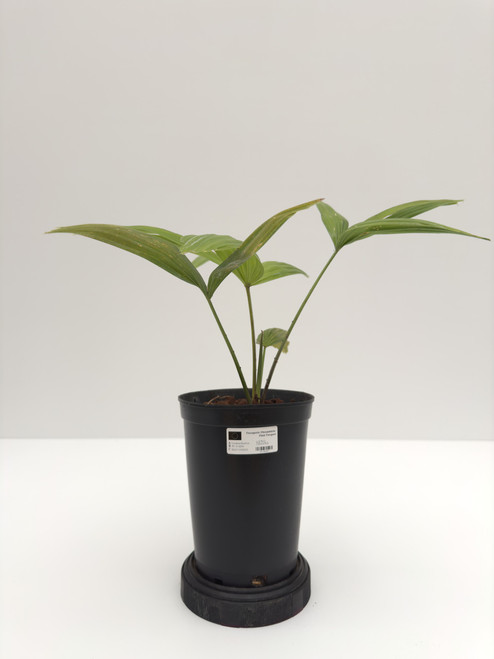Product Description
Habitat and Distribution
Japan. Bonin (Ogasawara), Kazan-retto, Ogasawara-shoto, and Volcano Islands - Endemic. Coastal and near coastal forest, 50-500 m alt.
Description
Hermaphroditic, Solitay palm. Trunk to 20 m tall, about 30 cm in diameter breast high, leaf scars raised, with remnant leaf-base fibres, internodes narrow, petiole stubs not persistent. Leaves 40-60 in a globose to flattened crown; petiole adaxially moderately ridged, margins with single curved green spines well spaced in proximal portion of petiole; leaf-base fibres not prominent, very coarse, persistent; lamina costapalmate, regularly segmented, subcircular, 120-200 cm long, adaxially grey-green, abaxially lighter grey-green, nonwaxy; lamina divided for 45-75% of its length, with 50-82 segments, depth of apical cleft ca 20% of the segment length; apical lobes pendulous; parallel veins 5-6 each side of midrib; transverse veins thinner than parallel veins. Inflorescences unbranched at the base, 130-220 cm long, not extending beyond the limit of the crown, branched to 3 orders; 6-7 partial inflorescences; rachillae 4-16 cm long, glabrous; prophyll not seen; peduncular bract 1, tubular, glabrous; rachis bracts tubular, glabrous. Flowers in clusters of 5-8, 2.0-2.8 mm long, cream. Fruit globose to pyriform, 19-30 mm long, 14-28 mm jn diam., glossy bright green; pedicel 3-4 mm long. Seed reniform. Eophyll not seen. (Dowe, J.L.) Editing by edric.
The first mention of Livistona boninensis was by Kittlitz (1844) in an account of his voyage through the northwest Pacific, where he noted "...eine grosse schöne Fächerpalme (Corypha japonica?)...", and included it in various illustrations of the Bonin Islands. Nakai (1936) argued that by Beccari (1921) who described it as a subspecies of L. chinensis in a diagnostic key to Livistona species, as L. chinensis var. boninensis. The first use of the name raised to specific rank as L. boninensis, was by Nakai (1928) in his Plants in Ogasawara Islands. Beccari (1931) maintained it as a subspecies of L. chinensis, and provided an expanded description. However, Nakai (1935) continued using the name at specific level, and placed Beccari's subspecies in synonymy. Moore & Fosberg (1956) re-established it as a subspecies, provided comparative illustrations with other subspecies, and established the type as Wilson 8271. Recently collected specimens seen at MAK, carry larger fruits than originally described, up to 30 mm long as opposed to 25 mm long in previous descriptions. Fruit are globose to subglobose with a tapered base. These differ from those in L. chinensis where those, are only up to 26 mm long in the largest specimens seen, varying from globose to ovoid but lacking any basal tapering. A peduncular bract is present in L. boninensis but is lacking in L. chinensis. There is also considerable difference in the degree of tomentum carried on the inflorescence bracts. In L. chinensis, the tomentum is dense and persistent, while in L. boninensis bracts are glabrous or only mildly tomentose becoming glabrous at maturity. Thus the taxon formerly known as L. chinensis var. boninensis is hereby reassigned to specific status in accordance with the taxonomy of Nakai (1935). (Dowe, J.L.)
Culture
USDA Hardiness, zone: 9B
Comments and Curiosities
Phenology: Flowering Apr-May; fruiting Oct-Dec.
- Livistona boninensis:
A single peduncular bract. Fruit bright green at maturity. Degree of tomentum carried on the inflorescence bracts is dense and persistent.
- Livistona chinenis:
Lacking peduncular bract. Fruit blue-green to bright green, glossy, epicarp ceramic-like at maturity. Bracts are glabrous or only mildly tomentose becoming glabrous at maturity. (Dave Witt)
"The very 1st piece of the inflorescence coming out of the stem is the prophyll (I think), the peduncular bracht emerges from this, there are no rachillae attached to it (sometimes they), the rachillae are what hold the flowers. So on chinensis you would see a prophyll immediately, followed by rachillae brachts, on boninensis palms, you'd see a single peduncular bracht w/ no rachillae, then rachillae brachts holding flowers." (Dave Witt)
"I think they are close enough geographically that cold hardiness wouldn't be a deciding issue but you never know til you check. No way to discern juveniles." (Dave Witt)
A newly described, rare species from the small Bonin Islands in the Pacific Ocean south of Japan. (RPS.com)






















